The reference to Dracula in the title is all about the garlic. As we all know, Dracula was a vampire, and vampires are fearful of garlic. This post is very garlic-centric … so if you are not interested in the background stuff, please scroll down and go straight to the recipe with the photos. Guaranteed to keep vampires at bay …
Many visitors to Italy have confided to me that they are baffled by the Italians’ hesitant, wary and sometimes even snooty attitude towards this most necessary of recipe enhancers; they can’t fail to notice how niggardly most Italians are with the amount of cloves included in any dish, or even how the garlic is removed altogether once it has been sautéed in olive oil towards the start of the recipe in question.
I personally hail from a family of garlic-galore inclination but this was eventually ironed out of me, gastronomically speaking, when first I began to cook regularly and enjoyed inviting people to dinner. The most diplomatic among them would say something like, “Wow Jo! just how much garlic did you put in this dish!” and reach for litres of water or wine to tame the lusty lingering flavour on their palate. I was rather mortified, naturally, but, nothing loath, forged ahead with my experiments in the kitchen, toning down the amount of garlic until I got it to be ‘Italian-friendly’. I had a colleague at work at the time who was very fond of me and would too often come within unwelcome exhaling distance, her affection imbued with an overpowering halitosic souvenir of the garlic she had eaten the night before – so it wasn’t as if I were not sensitive to the whole ‘garlic breath’ scenario. She happened to be French. Another German colleague was even more liberal with his daily garlic intake and literally ‘infested’ the lift. One always knew when he had used the lift, his body left a garlicky smell-imprint leaving us in no doubt. These days, it would be the Romanians recently living in Italy who are likely to cause nostril-attack for the the whiff of garlic surrounding their person. So yes, the Italians are finicky about garlic.
I have an inkling, moreover, that the Italians have always been pernickety about their garlic intake – the middle class, bourgeois or aristocratic Italians that is and in this respect they would have been no different from other toffs in other countries. The poorer people couldn’t get enough of garlic and onions in their diet and their body odour was olfactive proof of this. So the smell of garlic was most likely associated with peasant fare, with poverty.
We know, on the other hand, that garlic was not a ‘normal’ ingredient in the British kitchen until Elisabeth David’s popular books introduced Mediterranean flavours and recipes in the 1950s to a country that had previously been highly diffident of this Allium sativum, perhaps even deeming it exotic, not to mention suspiciously ‘foreign’. Once the trend for garlic had set it, however, there was no stopping the garlic frenzy and the more-the-merrier became the mantra.
Not so with the prescriptive Italians, with their long history of local cuisine, which they are now appreciating more and more and looking to as a treasured heirloom: they are fully aware that garlic has its place in the kitchen, but it is one that has to be included with sedulous calibration. You can’t just breezily throw in cloves of garlic any old how à la Jamie Oliver! no! you have to know just how many cloves, and you have to cook the garlic properly, making sure it doesn’t change colour beyond golden! Watching Italian cooking programmes on TV, reading Italian cookery books or magazines, and listening to pronouncements made by chefs at cooking classes, I was unanimously informed that garlic is ‘sweet’ if cooked over a low heat, and for a short time, and that once it has imparted its fabulous flavour, it should be deftly and cold-bloodedly removed upon pain of it then wreaking revenge upon the recipe, by turning it bitter and ruining everything. Also, most chefs actually remove the sprout/germ from the garlic altogether. It is ironic that this germ is sometimes referred to as the ‘anima’, the soul, in Italian.
I am always on the look-out for good quality when it comes to food, and that of course includes garlic. For years now, I have been boycotting supermarkets as much as I can in any case for general reasons of business ethics but, when it comes to garlic, because of the supermarkets’ partiality to plugging garlic imported from China, India, Egypt and Spain. Nothing against these countries but I can’t for the life of me understand why Italy needs to import garlic in the first place. Second, Italian garlic tastes so much better – sorry, I do not want to offend anyone’s sensibilities, but it does! You need only one Italian clove for the equivalent of at least two or more as regards varieties from other countries. (And ssssh, don’t tell the customs officers, but I have been known to smuggle in Italian garlic to other countries when I visit and my friends and family are glad that I did.) The Italian garlic I use most of all (in that I have access to it) is the garlic from Sulmona in the Abbruzzo in Central Italy. Other famous garlics in Italy hail from Vessalico (Liguria), Voghiera (near Ferrara), Polesano (from Polesine in the Veneto), Aglio bianco di Molino dei Torti (near Alessandria in Piedmont). These are all regions in the north of Italy. The only famous garlic from the South would seem to be the Aglio rosso di Nubia di Paceco (close to Trapani in Sicily) but I have a feeling that more varieties exist in the South and just aren’t talked about.
Some people claim they find garlic undigestible – and who am I to disbelieve them? Everyone knows the workings of their own body. So … if you fall into the category of people who do indeed like their garlic but have to be careful not to be overpowered by it in their meals, you might like to discover the following tip.
Place the peeled garlic in a small pan with cold water. Bring the water to the boil, or just before rather. When the water bubbles about to simmer appear, drain the cloves. Put them back in the pan, add more cold water and repeat the procedure. Do it a third time. This can even be done using milk. What these three immersions in water do is make the garlic ‘milder’ without actually removing any of its taste.
I tried it. It worked. And here is a recipe for spaghetti.
 Actually, first of all put the water on to boil. Then grate the pecorino romano cheese. I say ‘first of all’ because grating cheese is something I do not like doing, and so I either get somebody else to do it for me … or get it over and done with first myself so that I can breathe better.
Actually, first of all put the water on to boil. Then grate the pecorino romano cheese. I say ‘first of all’ because grating cheese is something I do not like doing, and so I either get somebody else to do it for me … or get it over and done with first myself so that I can breathe better.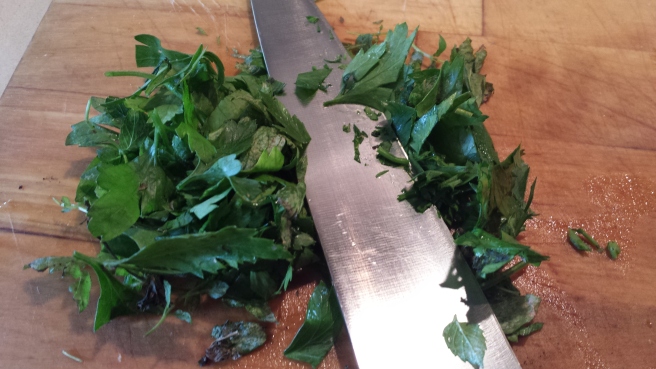 Chop a mixture of parsely and mint. Or parsely only. Or mint only. Whatever you prefer. I don’t think basil would work in this recipe, however.
Chop a mixture of parsely and mint. Or parsely only. Or mint only. Whatever you prefer. I don’t think basil would work in this recipe, however.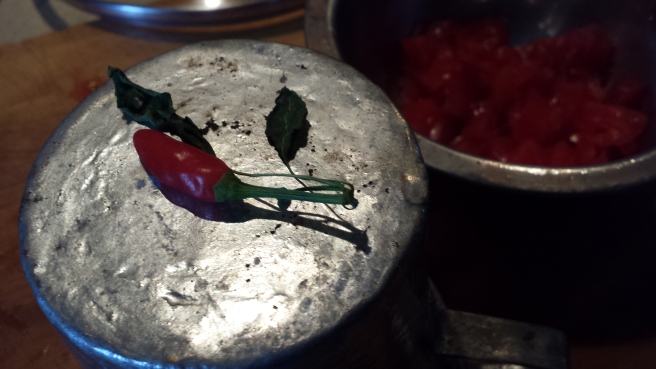 If you like heat, chop up some chilli or use chilli flakes.
If you like heat, chop up some chilli or use chilli flakes.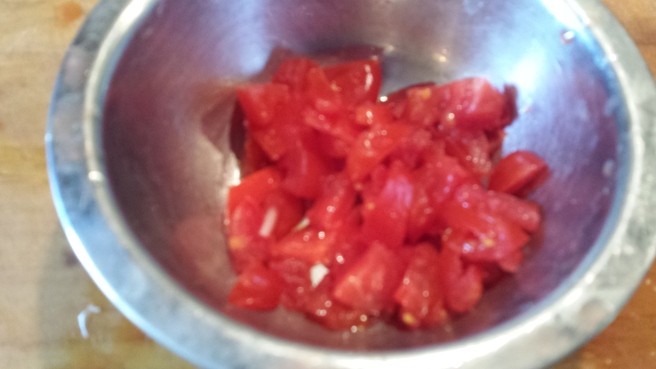 Chop up a couple of tomatoes and remove as much of the pulp and seeds as you are in the mood to do.
Chop up a couple of tomatoes and remove as much of the pulp and seeds as you are in the mood to do. Place the cloves of garlic in cold water. One clove per 100g of spaghetti and one more for the pot, the way one puts in 1 spoonful of tea leaves per cup and one more for the teapot.
Place the cloves of garlic in cold water. One clove per 100g of spaghetti and one more for the pot, the way one puts in 1 spoonful of tea leaves per cup and one more for the teapot.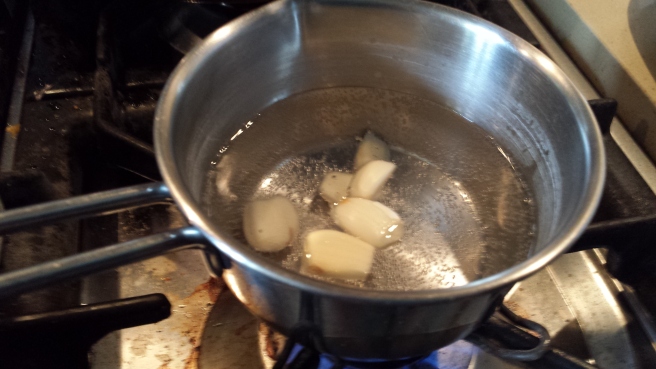 Turn on the heat. When tiny bubbles of simmer rise to the surface, immediately drain the garlic.
Turn on the heat. When tiny bubbles of simmer rise to the surface, immediately drain the garlic.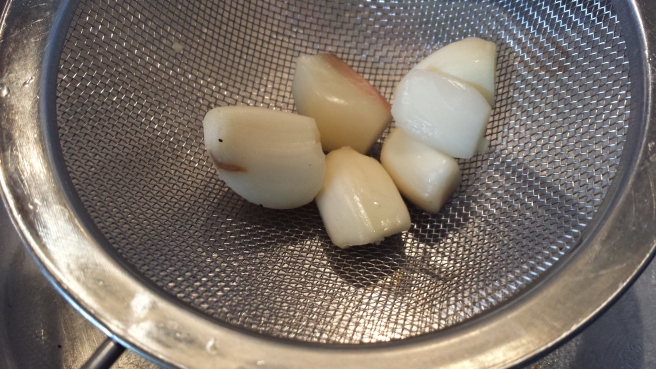 Put the garlic back in the pan, add water and repeat the procedure. Repeat the whole procedure once more. Then slice the garlic into fairly thin slithers. Thin slithers are required for this recipe.
Put the garlic back in the pan, add water and repeat the procedure. Repeat the whole procedure once more. Then slice the garlic into fairly thin slithers. Thin slithers are required for this recipe.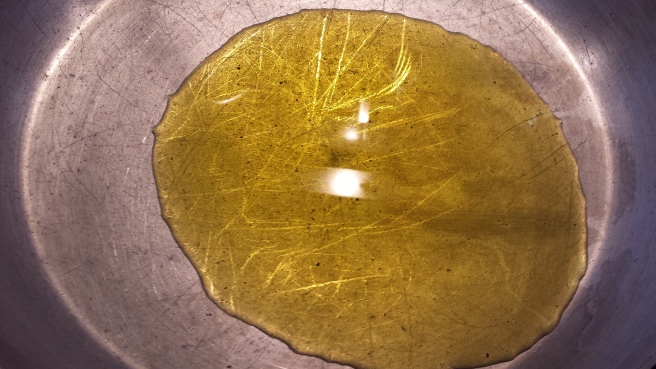 Pour the best quality olive oil you have into a saucepan.
Pour the best quality olive oil you have into a saucepan. Add the garlic and only now turn on the heat. Low. Low heat. We want the oil to be infused with the flavour of the garlic. The longer the garlic takes to cook the better. Keep a beady eye on the saucepan at this point ! blink and you’ll have missed the second the garlic went from golden to burnt! And then it will be too late … and it will be a case of Oh Woe is Me! Garlic disaster.
Add the garlic and only now turn on the heat. Low. Low heat. We want the oil to be infused with the flavour of the garlic. The longer the garlic takes to cook the better. Keep a beady eye on the saucepan at this point ! blink and you’ll have missed the second the garlic went from golden to burnt! And then it will be too late … and it will be a case of Oh Woe is Me! Garlic disaster. When the garlic has reached its golden colour stage, add the chopped tomatoes. And the chilli too, if you like it.
When the garlic has reached its golden colour stage, add the chopped tomatoes. And the chilli too, if you like it. And now and only now can you turn the heat up a little, and get the tomatoes to cook. A couple of minutes will do it. The sauce is ready. Switch off the heat. Taste and add some salt if necessary.
And now and only now can you turn the heat up a little, and get the tomatoes to cook. A couple of minutes will do it. The sauce is ready. Switch off the heat. Taste and add some salt if necessary.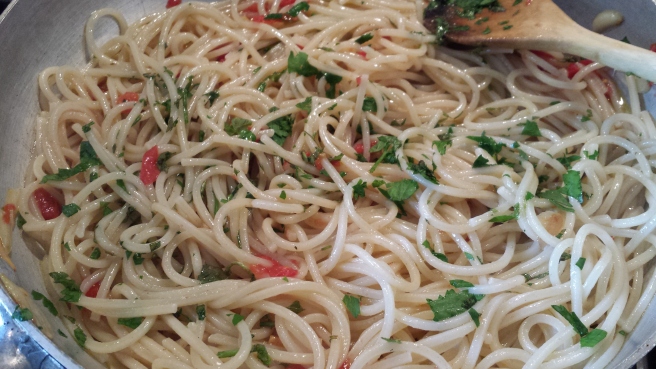 Drain the spaghetti directly into the sauce and the saucepan. Mix well so that the pasta is coated all over. Add the herbs last.
Drain the spaghetti directly into the sauce and the saucepan. Mix well so that the pasta is coated all over. Add the herbs last.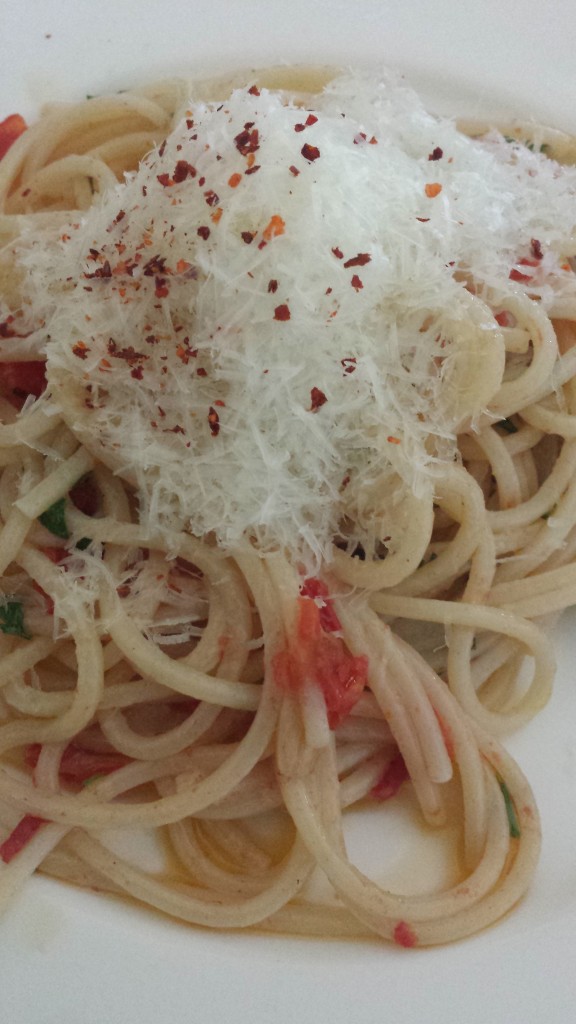
Add the pecorino and eat to your heart’s content. I like mine quite fiery so added more chilli flakes.
My husband and I ate these spaghetti very late in the evening, after we had come back from a day at the beach in Sabaudia. To put it mildly, we were starving. It took me literally 20 minutes from start to finish. We ended up eating amounts that would be frowned upon in the course of a normal Italian meal, but thoroughly approved of when pasta is the only food for dinner. In other words, we also ingested a lot of garlic. And yes … lo and behold … no ‘heaviness’, no indigestion, no garlicky breath the following day.
Thumbs up !
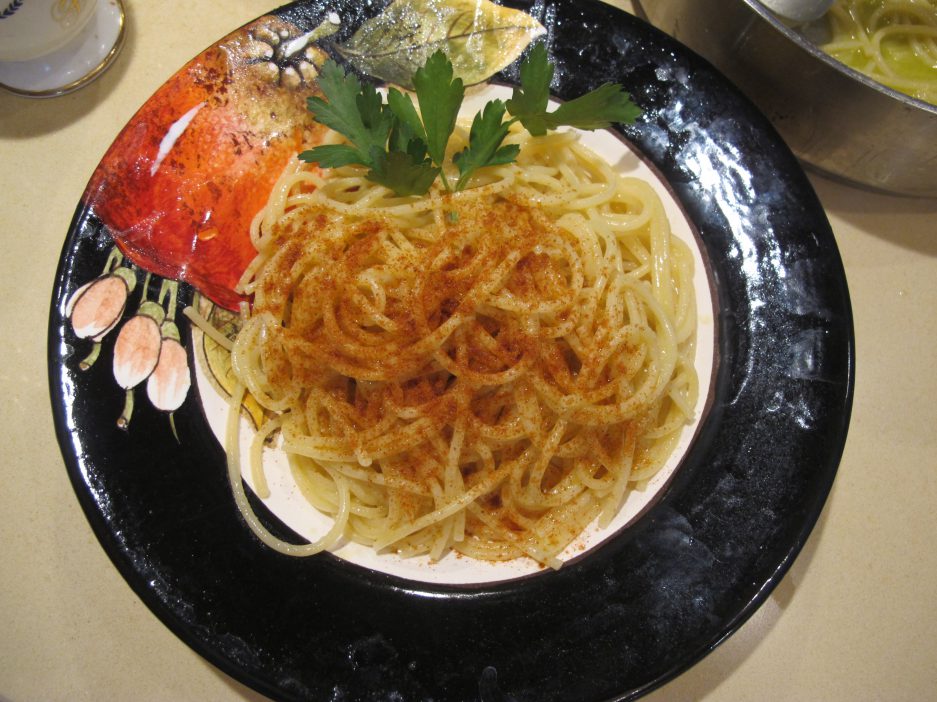
Interesting story about garlic, Jo. I realize I’ve picked up the Italian approach to garlic over the years — not surprisingly. I hate it when in American ‘Italian’ restaurant the tomato sauce (called marinara sauce there) is overpowered with the flavor of burnt garlic.
LikeLike
Burnt garlic is really not nice bleah …
LikeLiked by 1 person
As many of my (not authentic Italian) pasta dishes start with finely chopped rosemary, garlic and chili (or chili flakes when not in season), I was trying to think if such a combo had a name in Italian, like onion/carrot/celery = soffritto. But I guess not.
I was always bemused to see Italians taking out the germ, of removing the clove from a repassata. It’s the best bit of a repassata!
The garlic we’re using currently is from the in-laws’ garden. Inferior to Italian most likely but at least it’s not been shipped in.
LikeLike
Actually Daniel, I think that ‘battuto’ might come close to what you were wondering about. Un battuto di aglio, rosmarino e peperoncino … something like that. And yes … when it comes to ripassare vegetables (e.g. cicoria), I think it’s pretty stupid to remove the germ (l’anima!) from the garlic. And neither do I turn up my nose at rubbing garlic on toasted bread for a bruschetta … 🙂
LikeLiked by 1 person
I would definitely have to relearn how to cook in Italy as I never take the garlic out of a dish I’m preparing. A big plate of pasta is so easy to put together when coming home after a day out, yours looks delicious.
LikeLike
Aw thanks Karen !
LikeLike